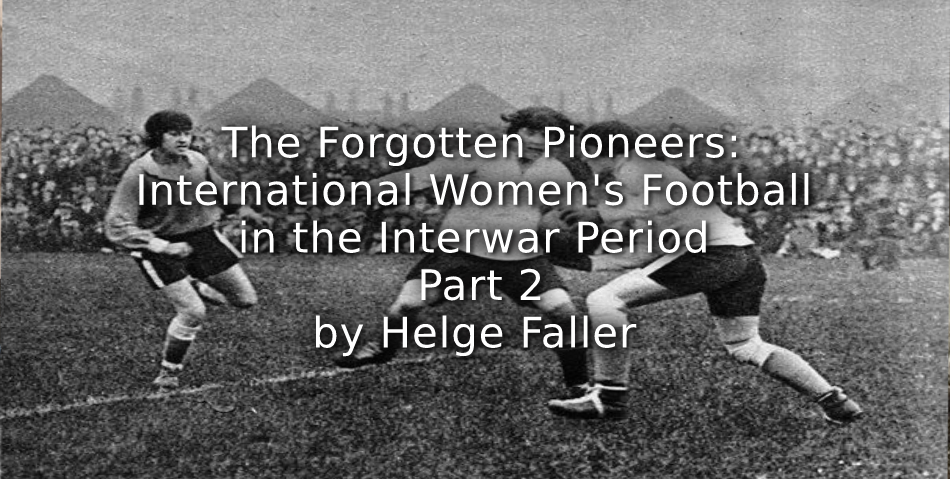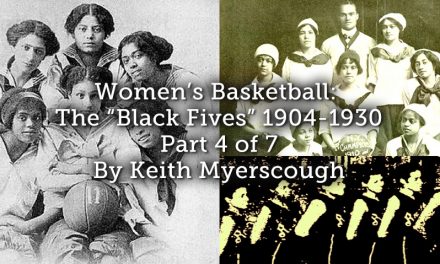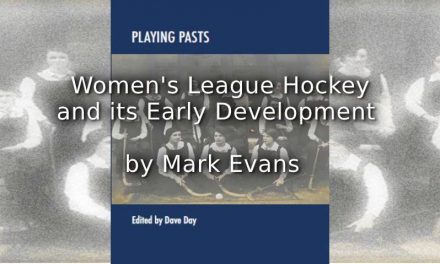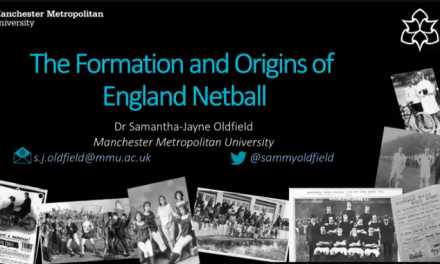To read Part 1 Click HERE
The 1922 Tours (1)
1922 saw two French teams touring England. French women’s sport (and women’s football) was still divided into two separate federations. Both played their own Parisian Championship. The F.S.F.S.F. had two divisions in Paris, both with seven teams. The Championnat de France was again played in a final match between the Parisian champion Les Sportives de Paris and the provincial team Sportives de Reims. Les Sportives won the championship. A new national cup was played (the Coupe La Française), in which ten teams participated and which was also won by Les Sportives. Finally, a competition for new clubs (the Coupe de l’Espérance) was played. Four Parisian and one provincial club (A.S. Tourquennoise) participated, and A.S. Amicale won this cup. During a match between the previous season’s champion En Avant! and Fémina Sport an incident caused a scandal, when Georgette Rigal threatened Baldracchi to slap her face and was thus sent off by the referee. Lead by Bracquemond, the whole team decided to leave the pitch at half-time in solidarity with their captain Rigal. En Avant! quit the F.S.F.S.F. soon afterwards and joined the rival organization F.F.F.G.S. This incident had some world-wide media coverage and was used as a bad example of how football supposedly brings out the worst in women. To scandalize Rigal’s action even more, the reports let her slap her opponent in the face while in fact she had only raised her hand and threatened Baldracchi to beat her (after the latter was constantly charging Rigal). En Avant! was still in a good position to win a third championship at that time of the season, having won all the matches so far. It was too late to join the rivalling F.F.F.G.S.-championship so Braquemond (and later Solange Guille) decided to leave En Avant! as playing members (Bracquemond remained an honourable member of the club) and join Les Sportives. This transfer during the season was possible as En Avant! was no longer part of the F.S.F.S.F., so Madeleine Bracquemond, captain of the national team, was able to play for “Le Tango”, as Les Sportives were frequently called after the colour of their shirts and winning the double with her new team (which had already beaten Fémina without her during the season).
The F.F.F.G.S. Championship consisted of three teams: Academia, La Clodo and Olympique de Pantin. Academia won the championship again with Olympique as runners-up (notwithstanding their prominent players Gouraud-Morris and the three Laloz-sisters). Academia proved their strength in their “welcome-match” against En Avant!, after the latter had changed federations, when they beat the still reigning champions of France 1-0.
England was now the second country in Europe with a federation for women’s footballers. The E.L.F.A. with its 60 members was very ambitious, planning a championship in three divisions and initiating a national cup. This cup was won by the Stoke Ladies, but the rush was soon over, as this was the only competition held by the new federation. One huge setback was the decision of Dick, Kerr’s and Hey’s Brewery, two of the strongest English teams, not to join the new federation. The E.L.F.A. planned several international matches by a national selection but in the end no match was played.

Violette Morris, Captain of Olympique de Pantin and the unofficial F.F.F.G.S.-selection in 1922
Source: Agence Rol / Courtesy of Gallica BNF
The first tour by a French team in the year 1922 was a bit confusing. Most of the English newspaper reports named the French touring side, who played Dick, Kerr’s and Hey’s Brewery, Olympique de Paris. The team that crossed the channel in March 1922 to play matches in Cardiff, Preston, Liverpool, Bradford and Manchester was put together by Violette Gouraud-Morris, the Olympique du Pantin captain. A try out was held for all clubs affiliated in the F.F.F.G.S. and finally a team consisting of players from Olympique, Academia and En Avant! faced their English opponents (and losing all matches – 0-3, 0-4,0-4, 1-5 against Dick, Kerr’s and 0-2 against Hey’s). Gustave de Lafreté, the de facto president of the federation asked Madame Gouraud-Morris not to call her team the official selection of the F.F.F.G.S., as they would play a kind of football he was strictly opposed to (normal ball, normal pitch). The team was therefore the inofficial F.F.F.G.S. selection. Apart from the match in Cardiff, where between 12,000 to 15,000 people attended the match, the public interest was nowhere near the craze of the 1920 and 1921 tours. Newspaper reports were rare and sketchy while the number of spectators was below expectations in most of the matches in England: Liverpool 2,000, Preston and Bradford 3,000. Only the match at Hyde Road Park was visited by about 8,000 to 10,000 people. The matches were all for a good cause. Half of the money was used for the British Empire Fund for the restauration of Reims Cathedral. Among the French team there were three former national players: Geneviève and Thérèse Laloz and Odile Bigot. The most prominent player apart from Violette Gouraud-Morris was Suzanne Guéry, captain of Academia and one of the best players never wearing the national sweater in France.

Several players of the F.F.F.G.S. selection
Back row (left to right): Thérèse Laloz, Ch. Renaud, Suzanne Guéry, Princess Murat (official), Madeleine Barat, Alice Guéry, Marguerite Laloz, Raoul Paoli (official)
Front row (left to right): Violette Morris, Geneviève Laloz, Blanche Kubuck?
Source: Agence Rol / Courtesy of Gallica BNF
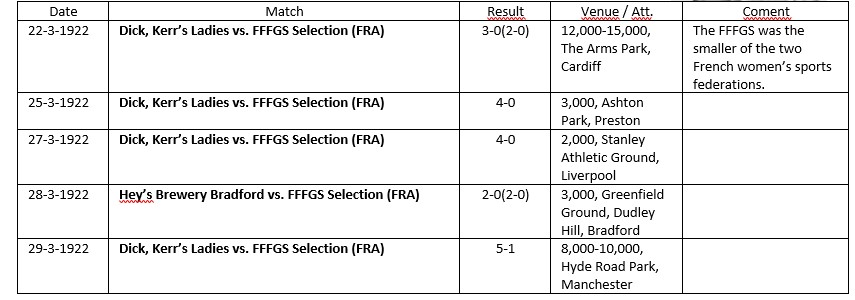
Table 2.1
The F.F.F.G.S. Tour of Wales and England 1922

Four main players in the 1922 international matches for the French teams
(left to right): Odile Bigot / En Avant! played for France in 1921 and the F.F.F.G.S. in 1922
Alice Guéry / Captain of Academia, one of the best players that never played for France
Simonne Chapoteau / Captain of Fémina Sport 1922-1924
Maria Charbonnel / Fémina Sport, one of the best full-backs in the early 1920s.<br<Source for all pictures: Agence Rol / Courtesy of Gallica BNF
The F.S.F.S.F. toured England for the third (and last) time. Again, Plymouth International Ladies (strengthened by one St. Helens and one Fleetwood player) were their opponents. This time, the team was a combination of six Sportives-players, four from Fémina and one from A.S. Amicale in the starting XI, with three more Fémina players as reserves of whom two didn’t play” during the tour. Pomiès joined France (she hadn’t played for Dick, Kerr’s against Olympique as far as we know), but the French team still wasn’t able to deal with the rough play by the International Ladies. The first match was almost abandoned when, after a series of hard tackles, Bracquemond ordered her team off the pitch but eventually was persuaded to play on. The French women decided to defend themselves with their fists. France lost the first match 1-2 and drew the other two 0-0. The media coverage was bad and the three matches were visited by rather disappointing crowds between 1,500 and 5,000 spectators.

Table 2.2
The F.S.F.S.F. tour of South England 1922
The US-tour of Dick, Kerr’s (2)
The autumn of 1922 saw an astonishing tour by the Dick, Kerr’s ladies to North America (joined again by Carmen Pomiès, who kept goal). Originally, a tour of Canada was planned (against female teams), but all matches during the tour were played against male professional teams in the North East of the United States. This was, as Alf Frankland stated, owing to the lack of female teams in North America (though there was soccer played by women in the Universities and there were also some clubs around). The results were remarkable at first sight – 3 won, 3 drawn and only 3 lost out of 9 matches with a goal-average of 40-40 (!). But reading the match reports, the male teams played “galant”, as in most the other men vs. women matches during that period, so they gave the women a fair chance to score, which they did. This explains results like 5-7 against Centro Hispano, 8-4 against New York FC or 5-6 against the Philadelphia Field Club. The main aim of the matches was to put up a great show for the spectators. Of course, for such a show you needed two teams who can play football, and the Dick, Kerr’s’ players played well without doubt. And they had some good press at home and in some other European newspapers.
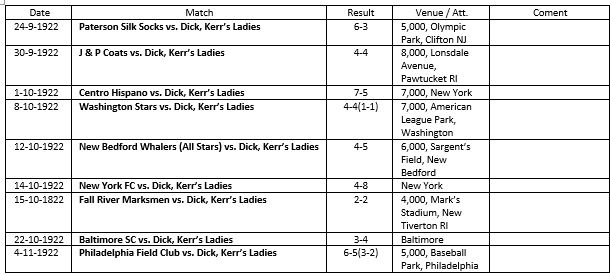
Table 2.3
The Dick, Kerr’s tour of the USA in 1922

Table 2.3
The Dick, Kerr’s tour of the USA in 1922
Hey’s international matches (3)
Another interesting match that autumn was Rutherglen’s first international match against upcoming Hey’s Brewery from Bradford, which had become a serious opposition for the Dick, Kerr’s in England. The match at Shawfield Ground before a very large crowd saw a superior team from Bradford winning 3-0.
Hey’s remained in the spotlight of the 1922-23 season when they visited France in April 1923 to play the French national team. Billed as the first full international match (which it wasn’t) by the official F.F.S.F. magazine Les Sportives, there was great public interest in the match which attracted between 5,000 and 8,000 spectators. Hey’s won a narrow match 1-0, which was abandoned five minutes before time when the spectators threatened to storm the pitch.

Hey’s defended well against France in Stade Pershing
Scene of the match with France threatening Hey’s goal
Source: Miroir des Sports 3-5-1923 / Archive Helge Faller

Table 2.5
International matches 1922-23

Jennie Harris, late Dick, Kerr’s, played for Hey’s in France
Edith Jackson, captain of Hey’s
Marcelle Lacombe of Sportives de Reims, official reserve player for France. The first player from the province to do so
Source for all pictures: Archive Helge Faller
At that time, French women’s football was reunited, as the two Federations F.S.F.S.F. and F.F.F.G.S. merged to the new F.F.S.F. Interestingly, the four clubs from the F.F.F.G.S.-Federation (Academia, Olympique, Clod, En Avant!) were by no means inferior to their counterparts, although they had played for up to two years under the “softer” rules of their federation. 19 teams participated in the three division of the Paris Championship and in Toulouse there was the first regional championship outside Paris. Women’s football was flourishing in France, while in England it was on the downward slope – not only because of the ban but also due to a lack of interest. With Belgium another country was now on the women’s football map after the pioneer Club Brussels Fémina was joined by a second club, U.A. de l’Innovation.
The next three seasons were a huge step forward into modern women’s football and this was thanks to the efforts of the French and Belgian women, with England gradually falling behind these two pace-makers.
The first (unofficial) Cup-Winners Cup (4)

Stoke and Les Sportives before one of their matches in Barcelona
Source: Stadium 15-9-1923 / Archive Helge Faller
In the summer of 1923, a new federation was founded in Belgium (F.S.F.B. – Féderation Sportive Féminin Belge) which was also responsible for women’s football, and organized the first championship of Belgium. In September, Barcelona made some women’s football history when Stoke and Les Sportives were invited to play for a cup. Originally Les Cadettes de Gascogne were asked to play in Spain, but the organization committee switched to Les Sportives as they proved the stronger team. The whole event was also planned as a tournament, but these two were the only ones to participate. This was a remarkable occasion in several ways. First of all, both teams were the cup-winners of the respective national federations in 1922, so this was something like an unofficial European cup-winners final. Besides, it was unusual at that time that two teams of two different countries played in a third country. And finally, this was one of the first (if not the first) example of an international women’s football competition. Both teams arrived by train. The two matches were organized by Cooperativo de Casas Baracas, an organization who provided houses for the weaker social classes. Stoke, who just had started playing football again in August after a break of nearly one year, came in their classic line-up while Les Sportives had to rely on some reserves and two guest-players from Olympique and A.S. Amicale, as some of their regular players were unable to take part in the journey.
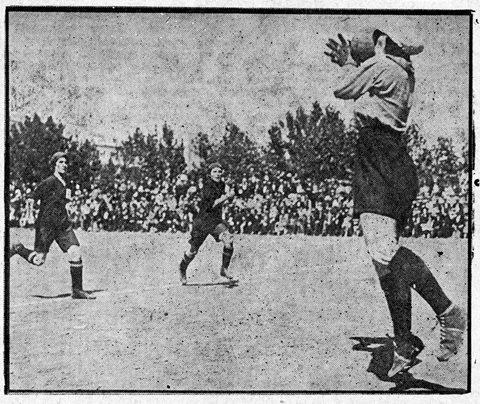
Scene of the match
Smachtens (Les Sportives) saved the ball, Stanyer and Derricott approaching
Source: Stadium 15-9-1923 / Archive Helge Faller
One prominent player from Fémina Sport was also on the train: Florrie Redford. After the US-tour Miss Redford joined Carmen Pomiès on her way back to France and played her first match for her new club Fémina in December 1922 in a test match versus Ruche Sportive. This was a true historic international transfer. While short engagements of Ourry and Trotman for Dick, Kerr’s just resulted in some occasional matches, Carmen Pomiés role was more substantial when she joined the Preston club in the summer of 1921. But Dick, Kerr’s didn’t play any kind of national or regional competitions and just toured Great Britain. In a way, the club could be compared to the famous Corinthians club, amateurs who never played the FA cup or in a league but were on the same level as (and sometimes better than) the best professional teams. But Redford took part in competitive matches for Fémina and was the most celebrated player in the French press during her one and a half seasons for Fémina. She didn’t play in any official match before spring 1923 and was thus not responsible for Fémina’s double (championship and cup). The cup was won by a walkover against l’Olympique after one of the biggest scandals in early French women’s football history. During a hard-fought match for the Paris championship between Fémina and Olympique the brother of the Laloz-sisters, unsatisfied with the performance of the young referee, entered the pitch an slapped the umpire in the face, soon joined by his sisters. The match was abandoned, the two Laloz twins Thérèse and Geneviève were suspended for two years (the suspension was later reduced to nine months) along with their captain Violette Morris (who wasn’t involved in the fight). The suspension of the latter was lifted a few weeks later as she wasn’t responsible. But Olympique lost three of their best players only a week before the cup-final against Fémina (whom they had beaten earlier that season). Olympique decided not to take part in the final the evening before the match, so Les Sportives played a friendly match versus Fémina instead, winning 1-0. In some sources Les Sportives was thus (incorrectly) called “cup-winner” of the 1922-23 season, but Fémina was the official winner.

Florence Redford who played for Fémina between 1922 and 1924 also played one match for Stoke and one for Dick, Kerr’s in September 1923
Source: Courtesy of Fémina Sports Archive
So back to the Stoke vs. Sportives match. Redford joined Stoke as a guest player in the first match. Les Sportives protested against the participation of who was without any doubt the best forward of that time, so it was decided that the first match was not for the cup and Redford wasn’t allowed to take part in the second match. In this first match Redford proved her reputation by scoring all three goals in the 3-0 win. The second match (now without Redford) was also won by Stoke, this time with a narrow 1-0 margin. Stoke had won the duel of the first national cup-winners.
Rutherglen beat Dick, Kerr’s (5)
Redford had a busy schedule in September / October 1923, as she headed to England to join Dick, Kerr’s for their match against Stoke. Dick, Kerr’s had played some matches against the Dumfries Ladies during the summer and one match against a combination of Glasgow and Dumfries women in the spring, winning all four matches by large margins (16-0 vs. Glasgow / Dumfries and 4-1, 5-0, 12-0 vs. Dumfries). The Scottish team was joined by ex-Chorley / Fleetwood / Vizard’s Bolton / Plymouth International player Polly Scott (who later became a member of Dick, Kerr’s). In another international match Dick, Kerr’s played a Rest of UK squad with players from England, Scotland, Wales and Ireland winning 3-1. But notwithstanding these convincing results, other teams caught up and were not only on the same level but even managed to win against the former best team in the world. According to Steve Bolton, they lost 1-3 against St. Helens in the spring (as Steve Bolton mentioned in his Part II on Carmen Pomiès), and September 1923 was even worse. They played Rutherglen on 14th September in Glasgow and lost 0-2 which was a true sensational result. Modern claims that Rutherglen had some Irish help for this match are extremely questionable. In a recent article it was said that Rutherglen was joined by Molly Seaton (and other Irish players), which should explain the unexpected win by the Scottish team. There are several problems with this claim. First, although this was one of the most important matches in Scotland of the 1920s, it was not possible to find a detailed match report. We only know that one of the two goals was scored by May Harrison. In the November 2012 edition of the magazine Scottish Memories, Eileen Kelly, the youngest daughter of James Kelly (founder of Rutherglen) gave us a line-up of this match. Most of the mentioned players (of which three were from Northern Ireland) didn’t match any of the players active for Rutherglen before 1925-26. Only the Wishart-sisters had played for Rutherglen by then. Others like May Harrison, the Stevenson-sisters (of whom Crissie was the Rutherglen captain) or Margaret Grozier weren’t even mentioned. The players Eileen Kelly mentioned were part of the Scotland (= Rutherglen) vs Ireland matches in 1927 and 1928. The problem of wrong memories, as vivid as they may be, in oral history was often critically discussed. Unless a team photograph, a match programme or a match report of the game have surfaced, there is no proof that Rutherglen recruited players from Northern Ireland for this match but didn’t rely on their captain or their upcoming top-scorer Grozier. Finally, no Irish source has been found so far that Molly Seaton caught attention as a footballer prior to 1927. All we can say is, that Dick, Kerr’s again was on the receiving end and lost back-to-back matches, despite Redford’s one-match appearance against Stoke a few days later.

Scene of the Match between Rutherglen and Dick, Kerr’s at Shawfield Ground
Source: Daily Record 16-9-1923

Table 2.6
Dick, Kerr’s vs. Scottish teams 1923
A scandalous tour (6)
While women’s football in Great Britain was reduced to occasional local matches and some show matches by the remaining “bigger” clubs, France and Belgium set the pace in women’s football in Europe. Fémina and a Paris selection were invited to tour Portugal in late September / early October 1923. They played matches against each other in Lisboa, Coimbra and Porto. The tour was a success as the teams attracted very good crowds but the aftermath shook women’s football in France in its foundations. To begin with, it was quite something for non-professional young women to go on a two-week trip in the 1920s. Their troupe was accompanied by F.F.S.F. president Alice Millat, who was carefully watching over the moral standards of women’s sport. It turned out that the female players not only attracted the (male) audience with their footballing skills but also with their “feminine charms”. So, love letters were written to the players (which they read out loud during breakfast), men tried to get into the hotel rooms (sometimes pretending that they were artists and only wanted to portray the women), some players even drove away with men, and there were also cases of sexual abuse. French women during the first half of the century were viewed as sexually libertarian, as described in the novel “La Garçonne”, and thus the Portuguese men viewed them as a “fair game”. The Portuguese sports journal Sporting (who was organizing and promoting the tour) was talking quite frankly about the incidents that happened during the tour, also mentioning that the French team was treated similarly during their stay in Great Britain. But the French public didn’t hear about this until the F.F.S.F. released a statement that 24 out of the 26 players were banned for a few weeks up to two years as a consequence of their “immoral behaviour” during their stay in Portugal. The only two players who weren’t sanctioned were Carmen Pomiès and Florence Redford. Lucienne Velu (Ruche Sportive, one of the best players in France) and Germaine Thomas (En Avant!) received the two year ban which indicates that they might have been among the players who willingly spend some time with men in Portugal. This was a fatal blow for some teams. Fémina, for instance, lost half of the team for a few weeks, which is one of the reasons why they lost their first-round game against Les Cadettes in the French Cup.

The Paris selection on attack against Fémina in Lisboa
Source: Ilustracao Portugeza 6-10-1923 / Archive Helge Faller

Table 2.7
The tour through Portugal 1923

The French players were invited by the Portuguese sports magazine Sporting
Source: Sporting 10-1923 / Archive Helge Faller
The first women’s full internationals (7)
The trouble over the harsh reaction of the F.F.S.F. overshadowed two matches in February 1924 which made world history in women’s football. After Belgium had started their national championship in December 1923, both federations planned two international matches of their respective official national selections. This was the first time that two national federations organized matches of their national selections. The French national team had some experience as they had played English club teams between 1920 and 1923, while for Belgium this was a premiere after only 10 months of organized women’s football. These two matches were the first full internationals by modern standards. Both federations played only with players that were French or Belgian. This excluded Florence Redford, for instance, but also one of the best outside-rights in France, Jeanne Ivanov-Zarraga, who was Russian. The French federation also had the rule that only two foreign players were allowed to take part in a domestic match for a club. Belgium had more trouble to find a suitable ground for the match as the male Belgian football federation was strongly against women’s football and forbade the use of grounds belonging to associated clubs. So, the original planned venue in Schaerbeek had to be cancelled and the F.S.F.B. was under pressure to find a ground in time. The venue they finally chose was spectacular but not really suitable for football. It was the Palais de Sports, an indoors velodrome which hardly had enough space for two full XIs (the field in the centre measured only about 80 x 40m). But the federation wanted the match to be played, so both teams lined up on 17th February 1924 before approximately 1,200 to 1,500 spectators to play the first full international (which was also the first full international match played indoors). Belgium played with their strongest possible team but in the French teams several well-known names were missing. This was a consequence of a boycott of several clubs in protest of the Portugal-sanctions. Fémina, Les Cadettes, En Avant! and Ruche refused to send any players. But the French team was strong enough. The players from Clodo, the upcoming Cup-winner, were the backbone of the team, including three Laloz-sisters, as Thérèse and Geneviève Laloz had been pardoned two months earlier from their ban after the fistfight in the Olympique vs. Fémina match in 1923. A strong forward from A.S. Amicale with German roots, Julienne Zimmermann, shone during both matches and Solange Guille from les Sportives played in the second match. Another star-player of Les Sportives was also missing: Madeleine Bracquemond. Undoubtedly one of the best French players, she was taking a break from football after she had travelled Portugal with the two French teams. She was offered a movie career there and didn’t return to football until the upcoming 1924-25 season. Belgium had only four active clubs. Some of the prominent players on their side were Philomène Vandenberghe (Atalante), Louise Vandeputte (Inno), Françoise Desmedt (Brussels Fémina) and Adrienne de Trogh (Olympic Fémina Club). Although they were lacking technical skills, Belgium fought very hard against the superior French team who scored the first goal through Thérèse Laloz after only ten minutes. Five minutes later the Belgian players erupted in joy as Vandenberghe scored the equalizer. The match was fairly even in the first half. In the second half, France was getting stronger and finally got the winner thanks to a shot by Julienne Zimmermann. Referee L. Hamus from the Luxembourg federation, who was strongly in favour of women’s football, had no problems with the match and was very delighted with the standard of play in an interview after the match.

Belgium attacking the French goal at Palais de Sport in Brussels-Schaerbeek in the first women’s full international
Source: Patriote Illustré 21-2-1924 / Archive Helge Faller

Julienne Zimmermann scoring the 1-0 at Stade Pershing in the second full international between France and Belgium
Source: Agence Rol / Courtesy of Gallica BNF
Just a week later, Belgium was travelling to France, fielding Elize Van Truyen from Brussels Fémina in goal, who was the world record holder in high jump. All French or Belgian teams of that time had some remarkable sports-women who succeed in other sports as well (mostly athletics but also swimming, cycling and other team sports like Basketball, Water polo or Barrette, the female form of Rugby in France). France had some trouble getting an XI together as there was an important cross-country event in connection with the international match. So Andrée Winter of Nova Fémina stepped in for her only full international after she just had taken part in the cross-country run. It was a cold day in Stade Pershing, but nonetheless about 5,000 people came to watch the match on the snow covered stands. Belgium was in the defence almost the entire match but somehow managed to hold the scores even up to 15 minutes before the end. But then the superior stamina of the French team resulted in three clear goals in the last quarter of an hour. Julienne Zimmermann, Marguerite and Thérèse Laloz were responsible for a safe French win. Hamus was again the referee. Both matches lasted for only 60 minutes each while all later full internationals were played 70 minutes.

Some of Belgium’s best players in the first two internationals
(left to right): Elize Van Truyen / Brussels Fémina, goalkeeper in the second match and high jump world record holder at the time of the match
Françoise Desmedt / Brussels Fémina, played football up to 1939
Louise Vandeputte / U.A. de l’Innovation. One of the backbones of her team which won the first to championships of Belgium
Philomène Vandenberghe / Atalante de Jette, scorer of Belgium’s first goal
Source for all pictures: Agence Rol / Courtesy of Gallica BNF

Some of the outstanding French players in the first full internationals
(left to right): Gabrielle Bouchy / La Clodo, one of the best goalkeepers of France in the 1920s
Julienne Zimmermann / A.S. Amicale, born in Germany scored twice
Lucienne Laudré / La Clodo, on of the best forwards and runners of France in the 1920s
Andrée Winter / Nova Fémina, stepped in for one of the Laloz sisters
Source for all pictures: Agence Rol / Courtesy of Gallica BNF
Both matches were a success and the importance of these two first full-internationals for women’s football can’t be overestimated. Both matches were organized by the two respective federations and played under the guidance and the rules of the international women’s sports federation. France and Belgium therefore were true pioneers of modern women’s football, as they not only organized some spectacular tours or astonishing show-matches, but also several national championships and cups with rules that applied to all clubs. Above all, it was them who organized the first two women’s full internationals. The matches between Belgium and France were also the only full internationals between the wars.

Table 2.8
Full-internationals 1924-1930
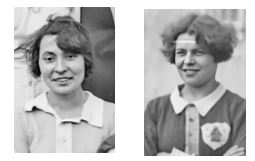
Germaine Thomas / En Avant ! (1918-1921), Olympique de Pantin (1921-1924), Fémina Sport (since 1924) on the left
Lucienne Velu / Ruche Sportive didn’t play for French national team in 1924 as they received a two-year-ban for unmoral behavior during the tour through Portugal
These two players received the harshest penalties from he association in connection with the scandal
The ban was lifted during the season but Velu quit football, although she was one of the best French forwards of her time
Source: Agence Rol / Courtesy of Gallica BNF
Belgium’s and France’s football mission (8)
It was in that season that Austria had its first small boom of women’s football. During the summer 1923 there were some “wild” matches, and in December the weekly newspaper Der Montag organized a training for women and later on founded the club D.F.C. Diana. Other male clubs created women’s football sections as well but after the widely reported so called “Ostmark”-match (as it was organized by the club Ostmark) in August 1924, Austria had to wait another ten years before women played organized football.
Meanwhile France and Belgium continued their development of women’s football on club level. Brussels Fémina and Nova Fémina de Paris met in Lille were the French club proved to be far superior to the Belgian pioneer club winning 7-0. Brussels Fémina and Belgian champion Inno (short form for U.A. de l’Innovation) then played the first known women’s football match in Esch / Alzette (organized by referee Hamus). 8,000 people watched the match and Inno won 3-1. This was a record crowd in Luxembourg that year which even the matches of the national team couldn’t equal.

Nova Fémina at Lille before their international premier against Brussels Fémina
Source: Dimanche de Roubaix 11-5-1924 / Courtesy of Gallica BNF

Table 2.9
International matches (including exhibition matches) 1924
1924-25 was a strange season in both countries, with lots of innovation but also turbulences in both federations. In August Inno and Olympic from Belgium played the first women’s football match in Dunkerque / France. It is interesting to note that the two-time Belgium champion didn’t ever play a team from outside Belgium despite playing outside Belgium two times. In October and November, the F.F.S.F. and the two clubs Fémina and Cadettes separated. The official reason was the sanction for Les Cadettes for playing two matches in August, thus breaking the rule that no football match was allowed during the athletics season (July / August). Les Cadettes were banned for two months. Fémina, who was still upset about the previous year’s Portugal sanction joined Les Cadettes a few weeks after they had left the federation, and both clubs decided to form a new federation, which was not under the “dictatorship” of Alice Milliat, who was in some press articles compared to Mussolini. Fémina’s exit from the federation didn’t came out of the blue. During the final stages of the French championship in Football and Barrette, Fémina’s founder Payssé suggested that his club should not compete in both national finals. This new federation, which was called Union Français des Sportives Féminine (U.F.S.F.), tried to convince the other clubs to join their federation, but only a few did. The new federation also organized a Parisian football championship in two categories, but only Fémina, Les Cadettes and their farm-teams took part. Fémina finally won the championship decider against Cadettes. It was only in Barrette that the U.F.S.F. was able to organize a national championship.

Adrienne de Trogh / Olympic Fémina Club, the outstanding full-back of early Belgian women’s football who also played in the first two full internationals
Source: Agence Rol / Courtesy of Gallica BNF
In Belgium Atalante went separate ways after François Wydemans wasn’t able to install his favourite choice, Mademoiselle Dumont, as president of the federation and then decided to leave the F.S.B.F., creating his own football league in December 1924.
These incidents were the reason why there was no full international in 1925, the only time between 1924 and 1937. But there were plenty of international matches, organized by the clubs of all four federations. In Belgium it was Atalante and Brussels Fémina who played internationally. Brussels was playing the return match against Nova Fémina in March 1925. Nova had just lost the final of the French cup and was stronger than in the previous season after players from Les Sportives (who closed their women’s football section in April 1924 in favour of cycling) and Fémina (who were obviously unsatisfied with the decision of their club to leave the F.F.S.F.) joined Nova. But surprisingly, Brussels, who was strengthened with a few players from Inno and Olympic, won against Nova (1-0) in perhaps the best match of the young Belgian football history up to that date. 6,000 spectators attended the match which was hard fought and produced several good moments of football. In retrospect, this was one of the crucial matches for Belgian women’s football in the interwar-period. Desmedt scored with a glorious volley in the 25th minute and Brussels had the chance to get two up just minutes later when they were awarded a penalty. But Desmedt just kicked the ball into the hands of Rita Lefébvre on purpose, which was common during the 20s, as this was seen as a gesture of fair play. In the second half, Petré saved a properly kicked penalty by Simonne Chapoteau, the ex-Fémina captain and Brussels ran out as winner.

Scene of one of the crucial matches in early women’s football history between Brussels Fémina and Nova Fémina
The Brussel defenders clearing against Simonne Chapoteau / Nova Fémina
The stadium was packed
As can be seen in the background, the spectators were even sitting on the fences
Source: Haagsche Courant 3-4-1925 / Courtesy of delpher.nl
Two more matches were played towards the end of the season after Brussels had just lost the championship decider against Inno. Les Cadettes were their opponent. At that time (end of May) the federations in both countries were reunited or on their way to reunite. For Belgium, the international women’s sport federation had to arbitrate, in France the ministry of sports helped in finding a new base for the two federations. Les Cadettes were a bit stronger than the previous season, one reason being their new right full-back Yolande Plancke, aged only 15 when she played her first international match for Les Cadettes. She was one of the reasons why Les Cadettes became a major player in French women’s football during the next two seasons although she never played for the French national team. She was a remarkable sports woman not only playing football on a top level but also being one of the best Barrette (Rugby) and Water polo players. And she was a great runner, competing in the 1928 Olympics. Both matches (in Brussels and Montreuil) were very close with the better end for Les Cadettes in their away-match (2-1) and a draw in the return-match (2-2). Both matches were celebrated in the press.
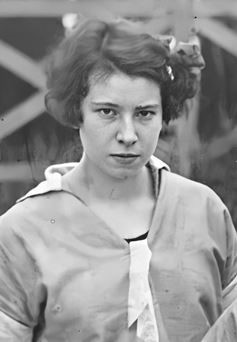
Yolande Plancke / Les Cadettes de Gascogne, was playing her first international match at the age of only 15 years
She was one of the most interesting figures in women’s sport, who played later for La Clodo but also Barrette / women’s Rugby for les Cadettes and goalie for the Mouettes water polo team, were she was also playing on international level
Above all she was one of the best runners in France, competing not only in the women’s Olympics but also in the 1928 Olympics
After she married, she only played one more year of football before she quit all sporting activities – a common fate for many French women athletes
Source: Agence Rol / Courtesy of Gallica / BNF
It was odd that (as far as we know) during the 1920a and 1930s no match between the two champions of Belgium or France was organized, but there were matches between champion and vice-champion or, like in the 1924-25 season, matches between the vice-champions Brussels, Nova (F.F.S.F.) and Cadettes (U.F.S.F.).
The first international league (9)
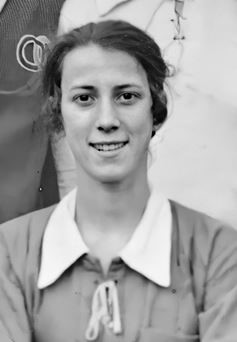
Marguerite Laloz / En Avant! ca. 1920-1921, l’Olympique de Pantin 1921-1923
La Clodo 1923-1924, Nova Fémina 1925, Golfers Club 1925-1928
helped Atalante de Lille during their first months and even played one match for Lille
She was one of the best French forwards in the 1920s and played also three times in the national team
Source:Agence Rol / Courtesy of Gallica BNF
Atalante had something special to offer in terms of international matches. The league Wydemans had formed (Ligue de Belgique Féminine de Football) was an international league. Apart from Atalante and their two farm-teams (En Avant and Elite) a team from Lille (also called Atalante) took part. Lille was founded that season as a reaction to the match between Nova and Brussels in 1924 in Lille and got some help from Marguerite Laloz, who competed in at least one of the test matches against a male schoolboy’s team (Juvenes). The Laloz sister had left Clodo at the end of the previous season and joined Golfer’s Club later on, a club without a football section. In the closing stages of the French championship, they played for Nova and held Olympique de Pantin to a draw before Nova was disqualified after the replay and banned for three months. Olympique became champion of France. The ban was another debatable decision by the federation as it was in connection with the behaviour of the Nova administration around an exhibition match in Dreux. Lille joined Wydeman’s league (and also played in the French cup and championship) with some remarkable results. At the end they were runners-up. Atalanta was winning their own league (as Fémina did), but both suffered one defeat (Atalante losing against Lille and Fémina against Cadettes). Another international tournament was staged in Brussels on Easter 1925. Atalante and En Avant on the Belgium side played Sportives de Reims and Atalante de Lille on the French side in the semi-finals with Atalante de Jette and Lille reaching the final after both semi-finals ended in a draw and were decided by toss of coins. Reims was upset how obviously the referee tossed the coin in favour of Atalante.
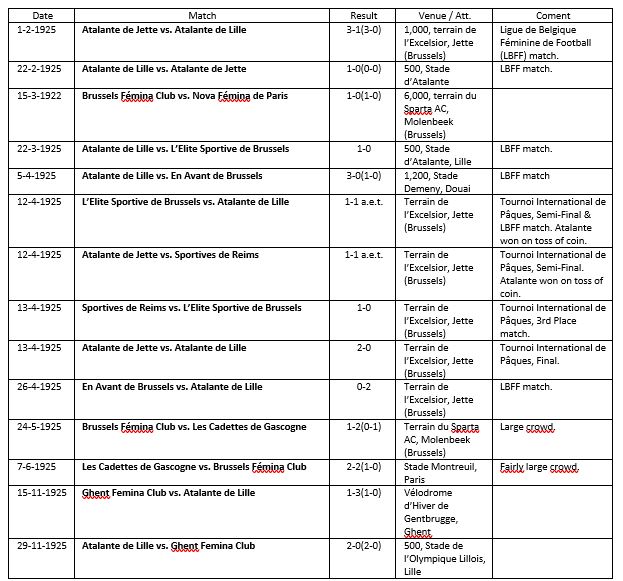
Table 2.10
International matches 1925
Two clubs in crisis (10)
For the British press and British researchers Fémina’s tour of England, Scotland and Northern Ireland was the main event in women’s football. The tour itself was a remarkable achievement, but the designation of the first Herne Hill match as “one of the most important football games in the history of women’s football” goes a bit too far. The tour also had no special name, so the designation “Les Gallery des Champions tour” sounds nice but has nothing to do with the original tour (which had no actual name). The Gallery de Champions was a series of photographs portraying male or female sports-men and sports-women by the Tres Sports magazine. Fémina’s minutes only declare that during the tour in England there would be no further travels by Barrette or Football teams from Fémina. The French newspapers had some pictures from the Herne Hill-match but with the exception of L’Auto most of the games weren’t even mentioned by the press. The reason why the pictures of the match at Herne Hill were spread worldwide wasn’t the importance of the match but the marketing genius of Alf Frankland. In fact, the tour was played by two clubs who weren’t at their best. Fémina had lost several good players and were not only beaten by Les Cadettes in their own championship but also by Olympique de Pantin just before leaving the F.F.S.F. Ida Rebardy in goal played her first season for the first team of Fémina, other players like Delpuëch, Dessard, Hélène Gillot, Thierry (later Bohn) and Pujade were from the second or even third teams. It was definitely not the strongest outfit Fémina had to offer, despite glorious names like Thérèse Brulé, Carmen Pomiés and Madeleine Bracquemond. Dick, Kerr’s still claimed to be world champions, a title without any foundation. They were certainly the best team during their hey-days in 1920-1922, but in 1923 they lost several matches and in 1924 at least Hey’s Brewery was on equal terms. Several well-known players of their “undefeated” period had left the team. One highlight was the return of Florence Redford for that tour who didn’t play in the French championship during the 1924-25 season. It was by any standards a “tour the force” with ten matches in sixteen days. Only in Hyde Fémina was able to win, holding Dick, Kerr’s to a draw on two other occasions (Manchester and Dumfries). The public interest was sometimes good (like Herne Hill with up to 6,000 spectators, in Manchester with 7,000 and in Belfast with about 10,000 visitors) but there were other matches were only 1,500 to 3,000 people saw the matches (Padiham, Dumfries, Kilmarnock and Chorley). The interest of the press wasn’t up to the standard of the early 20s with a lot of information lacking. The tour itself had no recognizable impact on women’s football worldwide or at least in England, Scotland, Ireland or France. It was in fact the last tour of a French team in Great Britain before 1932, when Fémina returned. Dick, Kerr’s played on for a couple of years but then abandoned football for the rest of the 1920s.

Ida Rebardy saving a ball just before Lilly Parr, with Maria Charbonnel on the left trying to help
The picture was taken during one of the first matches of the tour
Source: Miroir des Sports 20-5-1925 / Archive Helge Faller
After the tour, Fémina resettled and started to dominate French women’s football for almost a decade while Dick, Kerr’s only played some occasional matches before their break. The last two tours of Dick, Kerr’s and a French team (in 1922 and 1925) were both with teams from the rivalling federations of the F.S.F.S.F. / F.F.S.F. Somehow, Alf Frankland didn’t like the official side of organized women’s football.
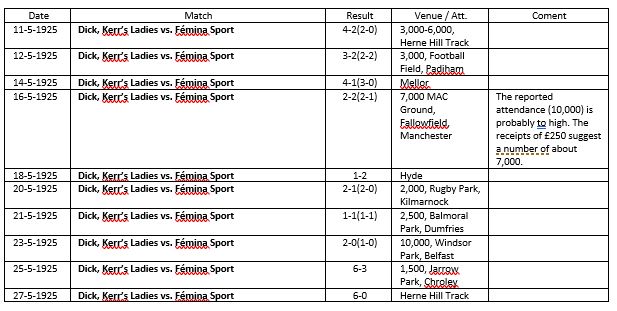
Table 2.11
The Dick, Kerr’s vs. Fémina-tour of England, Scotland and Northern Ireland in 1925
Article © Helge Faller 2021
Read Part 3 HERE
Acknowledgements:
The author would like to thank Patrick Brennan, who has done pioneering work in the research of women’s football before 1945, Stuart Gibbs for his great help in researching several international matches of the 20s by Dick, Kerr’s / Preston Ladies and invaluable information on Scottish women’s football during the interwar period, Xavier Breuil for some very helpful remarks on the F.S.F.I., Stipica Grigić for providing some very helpful remarks on Yugoslavian women’s football 1937-1939, Matthias Marschik for his tremendous support and Achim Trapp for reviewing the text.
Annotations (for a more detailed list contact the author):
- See “The Female Pioneers – A Statistical record of Women’s Football in Great Britain & Ireland from 1881-1953” (3 Vols.) by Helge Faller (2021, Les Sports et la Femme), “Les Footballeuses IV – La Saison 1921-22” by Helge Faller (2019, Les Sports et la Femme).
- See “The Female Pioneers”, “In a League of Their Own – The Dick, Kerr’s Ladies 1917-1965” by Gale Newsham (20183, Newsham), Carmen Pomies – The Most Important Women Footballer in History” by Steve Bolton (Parts I and II, Playing Pasts) https://www.playingpasts.co.uk/articles/football/carmen-pomiesthe-most-important-woman-footballer-in-historypart/
- See “The Female Pioneers”, “Les Footballeuses V – La Saison 1922-23” by Helge Faller (2019, Les Sports et la Femme).
- See “The Female Pioneers”, “Les Footballeuses VI – La Saison 1923-24” by Helge Faller (2020, Les Sports et la Femme), “Stoke Ladies 1921-1923” by Patrick Brennan, http://www.donmouth.co.uk/womens_football/stoke_ladies.html
- See “The Female Pioneers”, “Women’s Football in Interwar Scotland – Sadie Smith and the Legendary Rutherglen Ladies” (Parts I and II) by Fiona Skillen and Steve Bolton (2021, Playing Pasts) https://www.playingpasts.co.uk/articles/football/womens-football-in-interwar-scotlandsadie-smith-and-the-legendary-rutherglen-ladies-fcpart-1/
- See “Les Footballeuses VI”
- See “Les Footballeuses VI”, “Hun Tijd Vooruit – De Geschiedenis van het Damesvoetbal in België 1921-1925” by Helge Faller (2018, Les Sports et la Femme).
- See “Les Footballeuses VI”, “Hun Tijd Vooruit”, “Les Footballeuses VII – La Saison 1924-1925” by Helge Faller (2021, Les Sports et la Femme), “Le Histoire du Football Féminin en Europe” by Xavier Breuil (2011, Noveau Monde Editions) – The best book on the connections between early women’s football and the F.S.F.I.
- See “Hun Tijd Vooruit”, “Les Footballeuses VII”
- See “The Female Pioneers”, “Carmen Pomies”, “In a League of Their Own”, “Les Footballeuses VII”.

